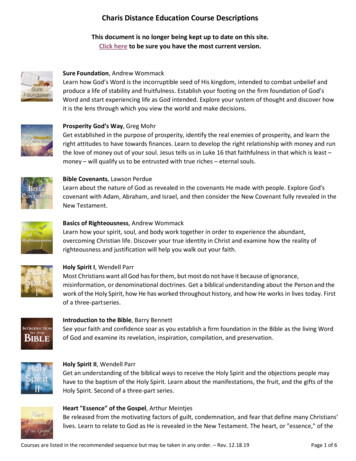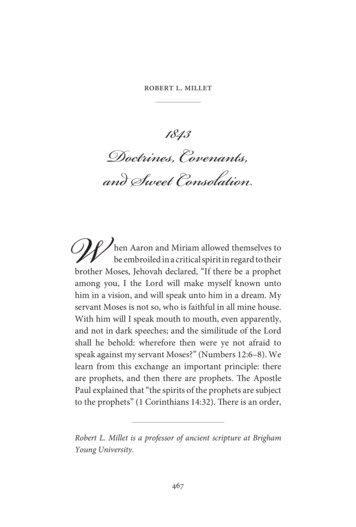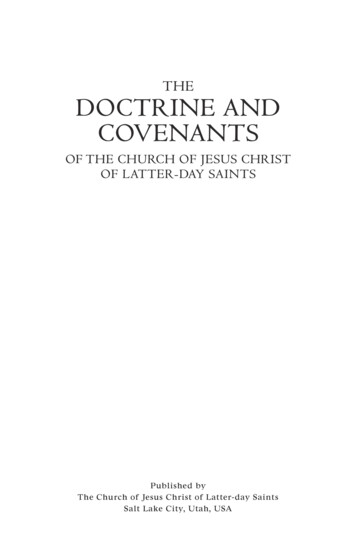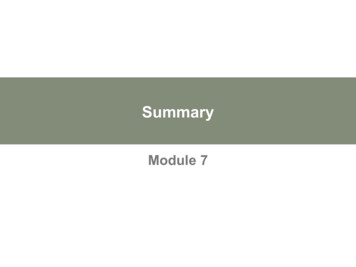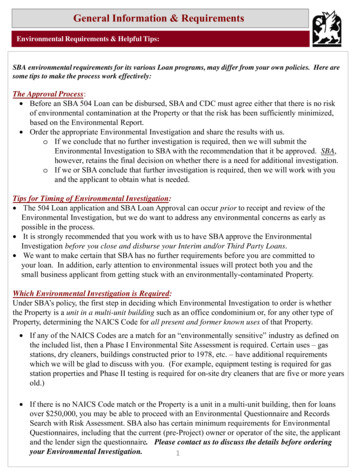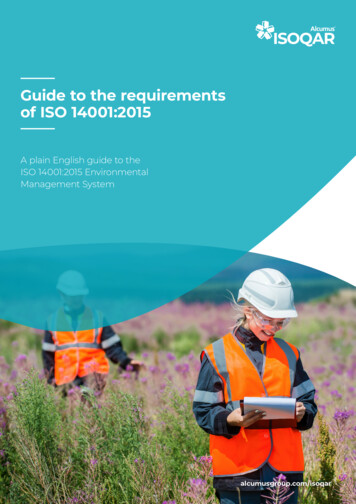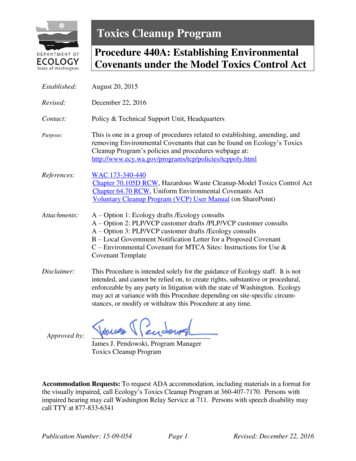
Transcription
Toxics Cleanup ProgramProcedure 440A: Establishing EnvironmentalCovenants under the Model Toxics Control ActEstablished:August 20, 2015Revised:December 22, 2016Contact:Policy & Technical Support Unit, HeadquartersPurpose:This is one in a group of procedures related to establishing, amending, andremoving Environmental Covenants that can be found on Ecology’s ToxicsCleanup Program’s policies and procedures webpage poly.htmlReferences:WAC 173-340-440Chapter 70.105D RCW, Hazardous Waste Cleanup-Model Toxics Control ActChapter 64.70 RCW, Uniform Environmental Covenants ActVoluntary Cleanup Program (VCP) User Manual (on SharePoint)Attachments:A – Option 1: Ecology drafts /Ecology consultsA – Option 2: PLP/VCP customer drafts /PLP/VCP customer consultsA – Option 3: PLP/VCP customer drafts /Ecology consultsB – Local Government Notification Letter for a Proposed CovenantC – Environmental Covenant for MTCA Sites: Instructions for Use &Covenant TemplateDisclaimer:This Procedure is intended solely for the guidance of Ecology staff. It is notintended, and cannot be relied on, to create rights, substantive or procedural,enforceable by any party in litigation with the state of Washington. Ecologymay act at variance with this Procedure depending on site-specific circumstances, or modify or withdraw this Procedure at any time.Approved by:James J. Pendowski, Program ManagerToxics Cleanup ProgramAccommodation Requests: To request ADA accommodation, including materials in a format forthe visually impaired, call Ecology’s Toxics Cleanup Program at 360-407-7170. Persons withimpaired hearing may call Washington Relay Service at 711. Persons with speech disability maycall TTY at 877-833-6341Publication Number: 15-09-054Page 1Revised: December 22, 2016
Washington State Department of EcologyToxics Cleanup Program Procedure 440AContentsBackground and Applicability . 3Procedure for Establishing an Environmental Covenant . 4Public Involvement Checklist for Establishing Environmental Covenants at Both VCP and FormalProcess Sites. 10General Public Notice Instructions . 11Attachment A – Option 1 (Preferred Option): Ecology drafts Covenant & Ecology consults withlocal land use planning authority . A-1Attachment A – Option 2: PLP/VCP customer drafts Covenant & PLP/VCP customer consultswith local land use planning authority . A-5Attachment A – Option 3: PLP/VCP customer drafts Covenant & Ecology consults with localland use planning authority . A-9Attachment B: Local Government Notification Letter for a Proposed Covenant . B-1When should I use this letter? . B-2To whom should I send this letter? . B-2Attachment C: Environmental Covenant for MTCA Sites: Instructions for Use and CovenantTemplate . C-1Instructions for Use . C-2Environmental Covenant for MTCA Sites: . C-8Covenant Template . C-8Environmental Covenant . C-9RECITALS . C-9COVENANT . C-10Section 1.General Restrictions and Requirements. . C-10Section 2.Specific Prohibitions and Requirements. . C-11Section 3.Access. . C-11Section 4.Notice Requirements. . C-12Section 5.Modification or Termination. . C-13Section 6.Enforcement and Construction. C-13Exhibit A . C-18Exhibit B . C-19Exhibit C . C-20Exhibit D . C-21APPENDIX 1 . C-23Publication Number: 15-09-054Page 2Revised: December 22, 2016
Washington State Department of EcologyToxics Cleanup Program Procedure 440ABackground and ApplicabilityWAC 173-340-440 of the Model Toxics Control Act (MTCA) regulation requires thatrestrictions be placed on the future use and activities at certain cleanup sites where residualcontamination remains after completion of a cleanup. The legal mechanism that is typically usedfor these restrictions is an “environmental covenant,” which is placed on the property title ordeed.An environmental covenant can be thought of as this: a restriction or obligation attached to aproperty that entitles somebody other than the owner (in this case, Ecology and other specifiedpersons) certain specific legal rights to ensure that the cleanup protects future users of theproperty, the environment, and the integrity of the remedial actions at the site.The Uniform Environmental Covenants Act (UECA), Chapter 64.70 RCW, was passed by theWashington State Legislature in 2007. That law establishes the process and procedures that mustbe followed for restrictions on future uses or activities at cleanup sites, so that the restrictionswill be valid and enforceable over the long term.Procedure 440A describes how to establish an environmental covenant at a site cleaned upunder MTCA authority.Note that this procedure refers to parties as though they were separate entities, including thepotentially liable person (PLP), the landowner, and owners of other property interests andencumbrances that may also need to grant the Covenant or subordinate their interests. 1 Thismay not be the situation at a particular site. For simplicity in this procedure, the landowner andowners of other interests and encumbrances are referred to collectively as the “propertyowner(s).”While the exact sequence of steps, as well as who conducts the work (Ecology, potentially liableperson (PLP) or Voluntary Cleanup Program (VCP) customer), may vary from site to site, all ofthe elements identified here must be addressed. The Cleanup Project Manager can adjustapproaches as necessary to reflect the site-specific situation.1An example of other property interests is an easement or right-of-way that is impacted by therestrictions. Examples of encumbrances are mortgages and liens. Persons holding these instrumentsmay need to either sign the Covenant as a “grantor” or sign a subordination agreement (meaning that therestrictions in Ecology’s Covenant take precedence over their interest, i.e. they “subordinate” theirinterest). See the Environmental Covenant template for further discussion of this topic.Publication Number: 15-09-054Page 3Revised: December 22, 2016
Washington State Department of EcologyToxics Cleanup Program Procedure 440AProcedure for Establishing an Environmental CovenantCleanup Project Manager1. Determines an Environmental Covenant(“Covenant”) is required under WAC 173-340440(4).2. Identifies issues to be addressed by Covenant.3. Either proceeds with Steps 1 through 4 or, sends aletter or email to the PLP or VCP customerrequesting that they complete one or more ofthese steps. See Attachment A for a suggestedformat for this letter or email, depending on thepath selected.Cleanup Project ManagerorPLP / VCP CustomerCleanup Project Manageror4. Contacts the local government land use planningauthority to inform them of need for a Covenantand seeks input on the conceptual terms of theCovenant; documents this conversation. 25. Arranges for a Title Company to conduct a titlesearch. 3PLP / VCP CustomerCleanup Project Manager(preferred)or6. Using Ecology’s template, works with propertyowner(s) to draft Covenant, and any necessarysubordination agreements. 4PLP / VCP Customer2UECA and MTCA require Ecology to consult with the local government land use planning authority.Ecology may require the PLP or VCP Customer to do this. But Ecology is ultimately responsible forensuring that the consultation occurs and the required information is obtained. If tribal lands are involved,consult with Ecology’s tribal liaison.The purpose of this consultation is to identify provisions in the Covenant that might conflict with current orfuture land use plans and development requirements for the property. It is recommended that an initialcontact be made via phone or e-mail to discuss the proposed scope of the Covenant. Once the Covenanthas been drafted, it should be sent to the local government for review (Step 11). See instructions in theEnvironmental Covenant template for a more comprehensive discussion of this topic.3In general, the title search should be the responsibility of the person conducting the cleanup. The titlesearch must identify all landowners and other persons holding an interest or encumbrance on theproperty. See instructions in the Environmental Covenant template for a more comprehensive discussionof this topic.4In general, the preference is that Ecology drafts the Covenant and subordination agreements. However,Ecology may request that the PLP or VCP Customer do this.Publication Number: 15-09-054Page 4Revised: December 22, 2016
Washington State Department of EcologyToxics Cleanup Program Procedure 440ACleanup Project Manager(if Ecology drafts Covenant)7. Sends draft Covenant and subordinationagreement(s), if applicable, to PLP / VCPCustomer and property owner(s) for review.PLP / VCP Customer(if drafting Covenant)8. Submits proposed draft Covenant andsubordination agreement(s), if applicable, and theresults of the title search to Ecology for review.Cleanup Project Manager9. Reviews draft Covenant or PLP / VCP Customerand property owner(s)’ comments on draftCovenant. If changes are made to the template,consults with AGO.NOTE: When establishing aCovenant, other than consulting withlocal government, there is noobligation to issue a public notice andcomment opportunity on the Covenant.However, where a Covenant isexpected to be used at formal processsites, this fact and any anticipatedrestrictions should be highlighted inthe public notice used for the CleanupAction Plan and the order or decree.(No public notice is required forCovenants at VCP sites.)10. After resolution of any issues, makes appropriatechanges to Covenant.11. Sends draft Covenant to local land use planningauthority for review. See Attachment B for asuggested format for this letter.12. After reviewing comments from local land useplanning authority, makes appropriate changes inconsultation with PLP and property owner(s).13. If appropriate, sends final Covenant andsubordination agreement(s) to PLP / VCPSee attached checklist for a summaryCustomer, with a request that they arrange forof public involvement requirements forsignatures.establishing a Covenant.PLP / VCP Customeror14. Arranges for property owner(s) to sign finalCovenant and subordination agreement(s).Cleanup Project Manager 5Property Owners(s)15. Signs Covenant as “grantor” of Covenant orsubordination agreement.Property Owner(s)16. Sends signed documents to Cleanup ProjectManager.orPLP / VCP Customer5Section Manager17. Upon receipt of final signed Covenant, signsCovenant as “holder” or “grantee” of Covenant.Cleanup Project Manager18. Retains a copy of the final signed Covenant andsubordination agreement(s).In general, the person conducting the cleanup should be responsible for collecting these signatures.Publication Number: 15-09-054Page 5Revised: December 22, 2016
Washington State Department of EcologyCleanup Project Manager (cont’d.)PLP / VCP CustomerorProperty Owner(s)Toxics Cleanup Program Procedure 440A19. Sends the PLP / VCP Customer the final signedCovenant and subordination agreement(s), with arequest that the documents be recorded.20. Records the final signed Covenant andsubordination agreement(s) with the CountyAuditor in every County where the real propertysubject to the Covenant is located.orEcology 6PLP / VCP CustomerorProperty Owner(s)orEcology 721. After recording, per RCW 64.70.070:a. Sends original recorded Covenant toEcology.8b. Sends a legible copy of the recordedCovenant, with the recording number evident,to the following persons: Each person who signed the Covenant or asubordination agreement. Each person holding a recorded interest inthe real property subject to the Covenant. Each person in possession of the realproperty subject to the Covenant at thetime the Covenant is executed (such asrenters). The local government planning authorityin which the real property subject to thecovenant is located. Any other person to whom the Covenantexpressly grants the power to enforce theCovenant. Any other person required by Ecology.6In general, this recording should be done by the person conducting the cleanup or the propertyowner(s).7In general, the distribution of the recorded documents should be done by the person conducting thecleanup or the property owner(s).8Some Counties retain the original. If that is the case, the Cleanup Project Manager should make sureEcology receives a legible copy of the recorded Covenant with all the signatures and the recordingnumber.Publication Number: 15-09-054Page 6Revised: December 22, 2016
Washington State Department of EcologyCleanup Project ManagerorAssigned Staff 9Toxics Cleanup Program Procedure 440A22. Retains a copy of the recorded Covenant andsubordination agreement(s) in the site file alongwith a note on where the original is located.23. Arranges for relevant information to be enteredinto ISIS and DSARS, and updates site web page,if applicable.24. Sends the original to HQ Fiscal Services forsafekeeping. If there is a secure file/safe in theRegional Office for sensitive legal documents, theoriginal may be placed there.9In some offices this is done by the Cleanup Project Manager; in other Offices the Community Outreachand Environmental Education Specialist or Administrative support staff may do this.Publication Number: 15-09-054Page 7Revised: December 22, 2016
Washington State Department of EcologyToxics Cleanup Program Procedure 440AThis page left intentionally blank.Publication Number: 15-09-054Page 8Revised: December 22, 2016
Washington State Department of EcologyToxics Cleanup Program Procedure 440APublic Involvement Checklist forEstablishing Environmental Covenants at Both VCP andFormal Process SitesPublication Number: 15-09-054Page 9Revised: December 22, 2016
Washington State Department of EcologyToxics Cleanup Program Procedure 440APublic Involvement Checklist for Establishing Environmental Covenants atBoth VCP and Formal Process SitesThe following public involvement steps are excerpted from Procedure 440A. Some of thesteps may be completed by the PLP or VCP customer, instead of Ecology. This is asummary checklist. For detailed instructions on how to complete these steps, and whoshould complete them, see Procedure 440A and the instructions included with theEnvironmental Covenant template. Conduct a title search to identify all persons currently holding a recorded interest in theproperty. Use this information to determine who needs to sign the Covenant or asubordination agreement. Notify and consult with local government officials to make sure the Covenant does notconflict with zoning and development regulations. Informal consultation first (by phone or e-mail) Formal consultation using letter template in Attachment B in Procedure 440A Public notice - Ecology is not required to issue a public notice and provide an opportunityfor the general public to comment when establishing a Covenant. However, because aCovenant can affect future uses of a property and potentially impact future developmentin the area, the following steps are recommended: For formal process sites, if a Covenant is anticipated when issuing a notice for acleanup action plan or order/decree, include a general description of anticipatedproperty restrictions with that notice. 10 For both formal process and VCP sites, if there is a high level of public interest inthe site and a public notice for the covenant cannot be combined with othernotices, consider providing a public notice and comment period specifically forthe Covenant. Update ISIS Create DSARs entry Update site web page (if applicable)10Formal process sites are sites where Ecology is doing the cleanup OR sites being cleaned up under anorder or decree.Publication Number: 15-09-054Page 10Revised: December 22, 2016
Washington State Department of EcologyToxics Cleanup Program Procedure 440AGeneral Public Notice InstructionsIf it is decided to issue a public notice (either separately or incorporated into another notice),the following additional tasks must be completed: Arrange for translation of site notices, fact sheets, and other documents as appropriate. Create and distribute postcard or fact sheet describing the proposed action. 300 foot radius for VCP sites. 11Quarter mile radius for formal process sites. 17Neighborhood and business associations encompassing site.Plus, any person or organization that has asked to be noticed. Create/update the site web page Create and arrange for the publishing of a Display or Legal Ad Create and submit a Site Register notice for publishing Add a notice to Ecology’s Public Calendar Inform your media consultant11Recommended distance. Actual distance may vary depending on level of public interest and extent ofpotentially affected vicinity.Publication Number: 15-09-054Page 11Revised: December 22, 2016
Washington State Department of EcologyToxics Cleanup Program Procedure 440AThis page left intentionally blank.Publication Number: 15-09-054Page 12Revised: December 22, 2016
Washington State Department of EcologyToxics Cleanup Program Procedure 440AAttachment A – Option 1 (Preferred Option):Ecology drafts Covenant &Ecology consults with local land use planning authorityPublication Number: 15-09-054Attachment A page 1Revised: December 22, 2016
Washington State Department of EcologyToxics Cleanup Program Procedure 440AAttachment A – Option 1 (Preferred Option)Ecology Drafts Covenant &Ecology Consults with Local Land Use Planning AuthoritySee Procedure 440A for additional instructions for using this letter.[Print on Ecology letterhead][DATE][PLP / VCP CUSTOMER][ADDRESS]Re:Proposed Activity and Use Restrictions at the following Cleanup Site: Site Name: [CLEANUP SITE NAME]Site Address: [CLEANUP SITE ADDRESS]Cleanup Site ID: [CSID NUMBER]Facility/Site ID: [FSID NUMBER]VCP Project ID: [VCP PROJECT NUMBER] (Delete if not applicable)Tax Parcels: [TAX PARCEL NUMBERS]Dear [PLP/VCP CUSTOMER]:The Department of Ecology (Ecology) has completed a review of your cleanup for the abovereferenced site. Because residual contamination will remain on the above-referenced property atthe completion of the cleanup, Ecology has determined that certain future activities and uses ofthe property need to be restricted under WAC 173-340-440 to protect the integrity of the cleanupand protect human health and the environment.Draft CovenantAccordingly we have prepared the attached DRAFT environmental covenant (hereafter“Covenant”) to implement the following restrictions on the property:[SUMMARY LIST OF RESTRICTIONS]We have also preliminarily consulted with [City/County] to seek their review of the restrictionsin accordance with RCW 70.105D.030(1)(f). Their initial feedback is that the restrictions arecompatible with their land use plan and development regulations for this property.Publication Number: 15-09-054Attachment A page 2Revised: December 22, 2016
Washington State Department of EcologyToxics Cleanup Program Procedure 440ARequest for Review and AssistanceEcology is sending you this letter to request that you do the following by [DATE]:1. Review the Covenant. If you have any concerns with any of the provisions, indicate whatthose concerns are and provide alternate language. Note that any changes to the templatewill require approval from the Attorney General’s Office.2. Complete the legal description in Exhibit A and prepare a property map for Exhibit B tothe Covenant.3. Conduct a title search to identify all persons holding an interest in, or encumbrance on,the real property subject to the Covenant.Please submit your comments on the Covenant, your drafts of Exhibits A and B to the Covenant,and the results of your title search to Ecology for consideration.Next StepsOnce we come to agreement on a final Covenant, you will need to:1. Obtain the signatures of each person holding a recorded interest in the property. Each ofthese persons will need to sign either the Covenant as a grantor or a subordinationagreement.2. Submit the Covenant to Ecology for our signature as the grantee.3. Record the Covenant in every county where the real property subject to the Covenant islocated. For detailed recording instructions, please refer to Chapter 65.04 RCW.4. Return the original signed and recorded Covenant to Ecology and provide a copy of therecorded Covenant to the following persons: Each person who signed the Covenant.Each person holding a recorded interest in the real property subject to theCovenant. This includes persons who signed subordination agreements.Each person in possession of the real property subject to the Covenant at the timethe Covenant is executed (i.e., renters).The local government planning authority in which real property subject to theCovenant is located.Any other person to whom the Covenant expressly grants the power to enforce theCovenant.Any other persons Ecology requires.The copy must be legible and the recording number must be evident.Publication Number: 15-09-054Attachment A page 3Revised: December 22, 2016
Washington State Department of EcologyToxics Cleanup Program Procedure 440AMore InformationFor more information on environmental covenants, see: Ecology’s environmental covenant es/tcppoly.htmEcology’s Toxics Cleanup Procedure cppoly.html.The Uniform Environmental Covenants Act (UECA), Chapter 64.70 RCW(http://apps.leg.wa.gov/RCW/default.aspx?cite 64.70).WAC 173-340-440 of the Model Toxics Cleanup Act (MTCA) Cleanup ?cite 173-340-440)If you have questions about how to complete the Covenant template or any of the directionsprovided above, please contact me at [PHONE] or [E-MAIL].Sincerely,[ECOLOGY CLEANUP PROJECT MANAGER]Enclosure: Proposed Environmental CovenantPublication Number: 15-09-054Attachment A page 4Revised: December 22, 2016
Washington State Department of EcologyToxics Cleanup Program Procedure 440AAttachment A – Option 2:PLP/VCP customer drafts Covenant &PLP/VCP customer consults with local land useplanning authorityPublication Number: 15-09-054Attachment A page 5Revised: December 22, 2016
Washington State Department of EcologyToxics Cleanup Program Procedure 440AAttachment A – Option 2PLP/VCP Customer Drafts Covenant &PLP/VCP Customer Consults with Local Land Use Planning AuthoritySee Procedure 440A for additional instructions for using this letter.[Print on Ecology letterhead][DATE][PLP/VCP CUSTOMER][ADDRESS]Re:Proposed Activity and Use Restrictions at the following Cleanup Site: Site Name: [CLEANUP SITE NAME]Site Address: [CLEANUP SITE ADDRESS]Cleanup Site ID: [CSID NUMBER]Facility/Site ID: [FSID NUMBER]VCP Project ID: [VCP PROJECT NUMBER] (Delete if not applicable)Tax Parcels: [TAX PARCEL NUMBERS]Dear [PLP/VCP CUSTOMER]:The Department of Ecology (Ecology) has completed a review of your cleanup for the abovereferenced site. Because residual contamination will remain on the above-referenced property atthe completion of the cleanup, Ecology has determined that certain future activities and usesneed to be restricted under WAC 173-340-440 to protect the integrity of the cleanup and protecthuman health and the environment. These restrictions include:1. [INSTITUTIONAL CONTROL #1].2. [INSTITUTIONAL CONTROL #2].Ecology has also determined that these restrictions need to be implemented in an Environmentalcovenant (hereafter “Covenant”).Request for AssistanceTo create a Covenant, Ecology is requesting that you do the following:1. Conduct a title search to identify all persons holding an interest in the real propertysubject to the Covenant. Generally, Ecology will not sign the Covenant unless all interestholders are willing to sign on as grantors or subordinate their interests. See step 5 below.Publication Number: 15-09-054Attachment A page 6Revised: December 22, 2016
Washington State Department of EcologyToxics Cleanup Program Procedure 440A2. Draft the Covenant implementing the above restrictions using the template documentavailable on the following web site. Please note that any changes to the templatelanguage in the Covenant must be approved by the Attorney General’s /tcppoly.html3. Submit the draft Covenant for review and comment to the appropriate land use planningauthority with jurisdiction over the site. See attached Ecology Procedure 440A for adescription of who to contact and a transmittal letter template. When requesting such areview, please: Send me a copy of your written request.Provide the authority with my contact information.Request that the authority send me a copy of any written response.Ecology will not approve the Covenant unless the authority has been adequatelyconsulted.4. After completing your consultation with the local land use planning authority, submit thedraft Covenant, along with a copy of the title search, to Ecology for review and approval.Please include any comments provided by the planning authority or, if none wereprovided, documentation of your consultation.5. Upon Ecology approval, obtain the signatures of all grantors of the Covenant and obtainsubordination agreements signed by any persons holding an interest in the real propertysubject to the Covenant who are not signing the Covenant as a grantor.6. After obtaining the signatures of the grantors and any necessary subordinationagreements, submit the Covenant to Ecology for its signature as the grantee.7. Upon obtaining Ecology’s signature, record the Covenant in every county where the realproperty subject to the Covenant is located. For detailed recording instructions, pleaserefer to Chapter 65.04 RCW.8. After recording, return the original signed and recorded Covenant to Ecology and providea copy of the recorded Covenant to the following persons: Each person who signed the Covenant.Each person holding a recorded interest in the real property subject to theCovenant.Each person in possession of the real property subject to the Covenant at the timethe Covenant is executed (i.e., renters).The local government planning authority in which real property subject to theCovenant is located.Any other person whom the Covenant expressly grants the power to enforce theCovenant.Any other persons Ecology requires.The copy must be legible and the recording number must be evident.Publication Number: 15-09-054Attachment A page 7Revised: December 22, 2016
Washington State Department of EcologyToxics Cleanup Program Procedure 440AMore InformationFor more information and instructions on how to create an environmental covenant, see: Ecology’s environmental covenant es/tcppoly.htmlEcology’s Toxics Cleanup Procedure cppoly.htmlThe Uniform Environmental Covenants Act (UECA), Chapter 64.70 RCW.(http://apps.leg.wa.gov/RCW/default.aspx?cite 64.70)WAC 173-340-440 (http://apps.leg.wa.gov/WAC/default
Cleanup Project Manager or PLP / VCP Customer 2 4. Contacts the local government land use planning authority to inform them of need for a Covenant and seeks input on the conceptual terms of the Covenant; documents this conversation. Cleanup Project Manager or PLP / VCP Customer 5. Arranges for a Title Company to conduct a title search.3

